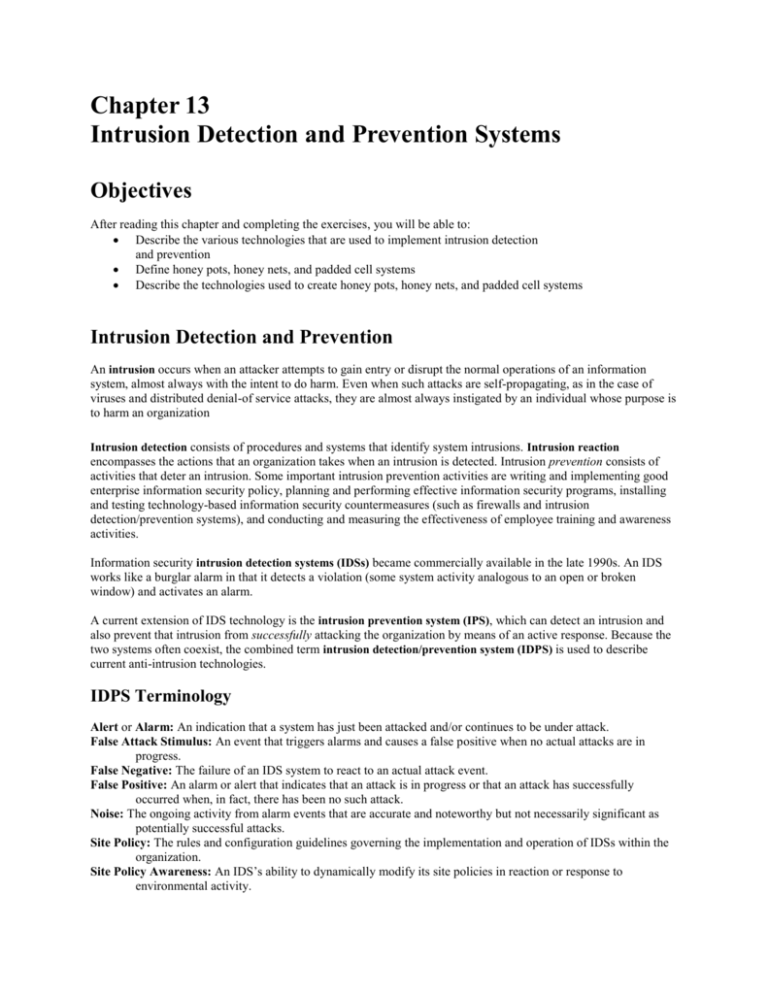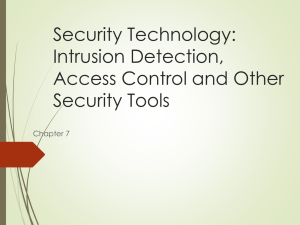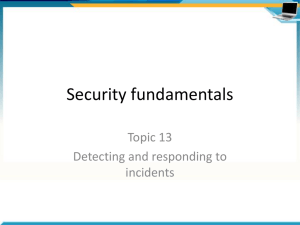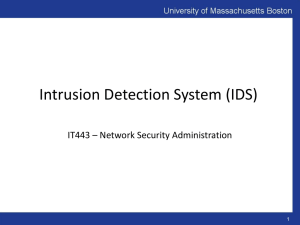Intrusion Detection and Prevention Systems
advertisement

Chapter 13 Intrusion Detection and Prevention Systems Objectives After reading this chapter and completing the exercises, you will be able to: Describe the various technologies that are used to implement intrusion detection and prevention Define honey pots, honey nets, and padded cell systems Describe the technologies used to create honey pots, honey nets, and padded cell systems Intrusion Detection and Prevention An intrusion occurs when an attacker attempts to gain entry or disrupt the normal operations of an information system, almost always with the intent to do harm. Even when such attacks are self-propagating, as in the case of viruses and distributed denial-of service attacks, they are almost always instigated by an individual whose purpose is to harm an organization Intrusion detection consists of procedures and systems that identify system intrusions. Intrusion reaction encompasses the actions that an organization takes when an intrusion is detected. Intrusion prevention consists of activities that deter an intrusion. Some important intrusion prevention activities are writing and implementing good enterprise information security policy, planning and performing effective information security programs, installing and testing technology-based information security countermeasures (such as firewalls and intrusion detection/prevention systems), and conducting and measuring the effectiveness of employee training and awareness activities. Information security intrusion detection systems (IDSs) became commercially available in the late 1990s. An IDS works like a burglar alarm in that it detects a violation (some system activity analogous to an open or broken window) and activates an alarm. A current extension of IDS technology is the intrusion prevention system (IPS), which can detect an intrusion and also prevent that intrusion from successfully attacking the organization by means of an active response. Because the two systems often coexist, the combined term intrusion detection/prevention system (IDPS) is used to describe current anti-intrusion technologies. IDPS Terminology Alert or Alarm: An indication that a system has just been attacked and/or continues to be under attack. False Attack Stimulus: An event that triggers alarms and causes a false positive when no actual attacks are in progress. False Negative: The failure of an IDS system to react to an actual attack event. False Positive: An alarm or alert that indicates that an attack is in progress or that an attack has successfully occurred when, in fact, there has been no such attack. Noise: The ongoing activity from alarm events that are accurate and noteworthy but not necessarily significant as potentially successful attacks. Site Policy: The rules and configuration guidelines governing the implementation and operation of IDSs within the organization. Site Policy Awareness: An IDS’s ability to dynamically modify its site policies in reaction or response to environmental activity. True Attack Stimulus: An event that triggers alarms and causes an IDS to react as if a real attack was in progress. Confidence Value: A value associated with an IDS’s ability to detect and identify an attack correctly. Alarm Filtering: The process of classifying the attack alerts that an IDS produces in order to distinguish and sort false positives from actual attacks more efficiently. Why Use an IDS? There are several reasons to use an IDS: To prevent problem behaviors by increasing the perceived risk of discovery and punishment for those who would attack or otherwise abuse the system To detect attacks and other security violations that are not prevented by other security measures To detect and deal with the preambles to attacks To document the existing threat to an organization To act as quality control for security design and administration, especially of large and complex enterprises To provide useful information about intrusions that do take place, allowing improved diagnosis, recovery, and correction of causative factors Network-Based IDPS A network-based IDS (NIDS) resides on a computer or appliance connected to a segment of an organization’s network and monitors network traffic on that network segment, looking for indications of ongoing or successful attacks. When a situation occurs that the network-based IDS is programmed to recognize as an attack, it responds by sending notifications to administrators. When examining the packets transmitted through an organization’s networks, a NIDS looks for attack patterns within network traffic, such as large collections of related items that are of a certain type that could indicate that a denial-of-service attack is underway, or it looks for the exchange of a series of related packets in a certain pattern, which could indicate that a port scan is in progress. NIDSs are installed at a specific place in the network (such as on the inside of an edge router) from where it is possible to watch the traffic going into and out of a particular network segment. The NIDS can be deployed to watch a specific grouping of host computers on a specific network segment, or it can be installed to monitor all traffic between the systems that make up an entire network. Wireless NIDPS A wireless IDPS monitors and analyzes wireless network traffic, looking for potential problems with the wireless protocols (Layers 2 and 3 of the OSI model). Unfortunately, wireless IDPSs cannot evaluate and diagnose issues with higher-layer protocols like TCP and UDP. Wireless IDPS capability can be built into a device that provides a wireless access point. Network Behavior Analysis System Network Behavior Analysis (NBA) systems examine network traffic in order to identify problems related to the flow of traffic. They use a version of the anomaly detection method described later in this section to identify excessive packet flows such as those that might occur in the case of equipment malfunction, denial-of-service attacks, virus and worm attacks, and some forms of network policy violations.NBA. Host-Based IDS A host-based IDS (HIDS) resides on a particular computer or server, known as the host, and monitors activity only on that system. HIDSs are also known as system integrity verifiers, as they benchmark and monitor the status of key system files and detect when an intruder creates, modifies, or deletes monitored files. Most HIDSs work on the principle of configuration or change management, which means they record the sizes, locations, and other attributes of system files. The HIDS then triggers an alert when one of the following changes occurs: file attributes change, new files are created, or existing files are deleted. A HIDS has an advantage over NIDS in that it can usually be installed in such a way that it can access information that is encrypted when traveling over the network. A HIDS relies on the classification of files into various categories and then applies various notification actions, depending on the rules in the HIDS configuration. Managed HIDSs can monitor multiple computers simultaneously by creating a configuration file on each monitored host and by making each HIDS report back to a master console system, which is usually located on the system administrator’s computer. Advantages of HIDSs A HIDS can detect local events on host systems and also detect attacks that may elude a network-based IDS. A HIDS functions on the host system, where encrypted traffic will have been decrypted and is available for processing. The use of switched network protocols does not affect a HIDS. A HIDS can detect inconsistencies in how applications and systems programs were used by examining the records stored in audit logs. Disadvantages of HIDSs HIDSs pose more management issues since they are configured and managed on each monitored host. A HIDS is vulnerable both to direct attacks and to attacks against the host operating system. A HIDS is not optimized to detect multi-host scanning, nor is it able to detect the scanning of non-host network devices, such as routers or switches. A HIDS is susceptible to some denial-of-service attacks. A HIDS can use large amounts of disk space to retain the host OS audit logs, and, to function properly, it may require disk capacity to be added to the system. A HIDS can inflict a performance overhead on its host systems, and, in some cases, may reduce system performance below acceptable levels. IDPS Detection Methods IDPSs use a variety of detection methods to monitor and evaluate network traffic. Three methods dominate: the signature-based approach, the statistical-anomaly approach, and the stateful packet inspection approach. Signature-Based IDS A signature-based IDS (also known as a knowledge-based IDS) examines data traffic in search of patterns that match known signatures—that is, preconfigured, predetermined attack patterns. Signature-based IDS technology is widely used because many attacks have clear and distinct signatures. The problem with the signature-based approach is that, as new attack strategies are identified, the IDS’s database of signatures must be continually updated. Statistical Anomaly-Based IDS The statistical anomaly-based IDS (stat IDS) or behavior-based IDS collects statistical summaries by observing traffic that is known to be normal. This normal period of evaluation establishes a performance baseline. Once the baseline is established, the stat IDS will periodically sample network activity and, using statistical methods, compare the sampled network activity to this baseline. When the measured activity is outside the baseline parameters, it is said to exceed the clipping level, and the IDS will trigger an alert to notify the administrator. The data that is measured from the normal traffic and is used to prepare the baseline can include variables such as host memory or CPU usage, network packet types, and packet quantities. The advantage of the statistical anomaly-based approach is that the IDS can detect new types of attacks because it is looking for abnormal activity of any type. Unfortunately, however, these systems require much more overhead and processing capacity than signature-based ones, as they must constantly compare patterns of activity against the baseline. Another drawback is that these systems may not detect minor changes to system variables and may generate many false positives. Stateful Protocol Analysis IDPS According to SP 800-94, “Stateful protocol analysis (SPA) is a process of comparing predetermined profiles of generally accepted definitions of benign activity for each protocol state against observed events to identify deviations. Stateful protocol analysis relies on vendor-developed universal profiles that specify how particular protocols should and should not be used.” By storing relevant data detected in a session and then using that data to identify intrusions that involve multiple requests and responses, the IDPS can better detect specialized, multisession attacks. This process is sometimes called deep packet inspection because SPA closely examines packets at the Application layer for information that indicates a possible intrusion. The analytical complexity of session-based assessments is the principal drawback to this type of IDPS method, which is further complicated by the amount of processing overhead in tracking multiple, simultaneous connections. Additionally, unless the protocol violates its fundamental behavior, this type of IDPS method may completely fail to detect the intrusion. One final issue is the possibility that the IDPS may, in fact, cause problems with the protocol it’s examining, especially with client- and server-differentiated operations. Log File Monitors Similar to a NIDS, a log file monitor (LFM) reviews the log files generated by servers, network devices, and even other IDSs for patterns and signatures in the log files that may indicate that an attack or intrusion is in process or has already succeeded. The patterns that signify an attack can be subtle and hard to distinguish when one system is examined in isolation, but they may be much easier to identify when the entire network and its systems are viewed holistically. Of course, this approach will require the allocation of considerable resources since it will involve the collection, movement, storage, and analysis of very large quantities of log data. IDPS Response Behavior Once an IDS detects an anomalous network situation, it has a number of options, depending on the policy and objectives of the organization that has configured it, as well as the capabilities of the organization’s system. IDS responses can be classified as active or passive. An active response is one in which a definitive action is initiated when certain types of alerts are triggered. IDSs with passive response options simply report the information they have already collected and wait for the administrator to take actions. IDPS Response Options When an IDPS detects a possible intrusion, it has a number of response options, depending on the organization’s policy, objectives, and system capabilities. When configuring an IDPS’s responses, the system administrator must exercise care to ensure that a response to an attack (or potential attack) does not inadvertently exacerbate the situation. The following are some of the responses that an IDS can be configured to produce. Audible/visual alarms SNMP traps and plug-ins E-mail messages Pager or phone messages Log entries Evidentiary packet dumps Take action against the intruder Launch program Reconfigure firewall Terminate session Terminate connection Reporting and Archiving Capabilities Many, if not all, commercial IDPSs provide capabilities to generate routine reports and other detailed information documents. Some of these can output reports of system events and intrusions detected over a particular reporting period (for example, a week or a month). Failsafe Considerations for IDPS Responses Another factor to consider is the failsafe features of the IDPS design or product. Failsafe features protect the IDPSs from being circumvented or defeated by an attacker. For instance, IDPSs need to provide silent, reliable monitoring of attackers. Selecting IDS Approaches and Products The wide array of intrusion detection products available today addresses a broad range of organizational security goals and considerations. Given that range of products and features, the process of selecting products that represent the best fit for any specific organization’s needs is challenging. The following questions may be useful when preparing a specification for acquiring and deploying an intrusion detection product. Technical and Policy Considerations What is your systems environment? What are the technical specifications of your systems environment? What are the technical specifications of your current security protections? What are the goals of your enterprise? How formal is the systems environment and management culture in your organization? What are your security goals and objectives? Is the primary concern of your organization to be protected from threats that originate outside of your organization? Is your organization concerned about insider attacks? Does your organization want to use the output of your IDS to determine new needs? Does your organization want to use an IDS to maintain managerial control over network usage? What is your existing security policy? How is it structured? What are the general job descriptions of your system users? Does the policy include reasonable use policies or other management provisions? Has your organization defined processes for dealing with specific policy violations? Organizational Requirements and Constraints What are the requirements that are levied from outside the organization? Is your organization subject to oversight or review by another organization? Are there requirements for public access to information on your organization’s systems? Are there other security-specific requirements levied by law? Are there internal audit requirements for security best practices or due diligence? Is the system subject to accreditation? Are there requirements for law enforcement investigation and resolution of security incidents? What are your organization’s resource constraints? What is the budget for acquisition and life cycle support of intrusion detection hardware, software, and infrastructure? Is there sufficient existing staff to monitor an IDS full time? Does your organization have authority to instigate changes based on the findings of an IDS? IDPSs Product Features and Quality Is the product sufficiently scalable for your environment? How has the product been tested? Has the product been tested against functional requirements? Has the product been tested against attack? Ask vendors for details of the security testing to which its products have been subjected. What is the user level of expertise targeted by the product? Is the product designed to evolve as the organization grows? Can the product adapt to growth in user expertise? Can the product adapt to growth and change of the organization’s systems infrastructure? Can the product adapt to growth and change of the security threat environment? What are the support provisions for the product? What are commitments for product installation and configuration support? What are commitments for ongoing product support? Are subscriptions to signature updates included? How often are subscriptions updated? How quickly after a new attack is made public will the vendor ship a new signature? Are software updates included? How quickly will software updates and patches be issued after a problem is reported to the vendor? Are technical support services included? What are the contact provisions for contacting technical support? Are there any guarantees associated with the IDS? What training resources does the vendor provide as part of the product? What additional training resources are available from the vendor and at what cost? Strengths and Limitations of IDPSs Intrusion detection systems perform the following functions well: Monitoring and analysis of system events and user behaviors Testing the security states of system configurations Baselining the security state of a system and then tracking any changes to that baseline Recognizing patterns of system events that correspond to known attacks Recognizing patterns of activity that statistically vary from normal activity Managing operating system audit and logging mechanisms and the data they generate Alerting appropriate staff by appropriate means when attacks are detected Measuring enforcement of security policies that are encoded in the analysis engine Providing default information security policies Allowing non-security experts to perform important security monitoring functions Intrusion detection systems cannot perform the following functions: Compensating for weak or missing security mechanisms in the protection infrastructure Instantaneously detecting, reporting, and responding to an attack when there is a heavy network or processing load Detecting newly published attacks or variants of existing attacks Effectively responding to attacks launched by sophisticated attackers Automatically investigating attacks without human intervention Resisting attacks that are intended to defeat or circumvent them Compensating for problems with the fidelity of information sources Dealing effectively with switched networks Deployment and Implementation of an IDPS Deploying and implementing an IDPS is not always a straightforward task. The strategy for deploying an IDPS should consider a number of factors, the foremost being how the IDPS will be managed and where it should be placed. IDPS Control Strategies An IDS can be implemented using one of three basic control strategies. A control strategy determines how an organization exerts influence and maintains the configuration of an IDS. The three commonly utilized control strategies are: A centralized IDS control strategy implements and manages all IDS control functions in a central location. A fully distributed IDS control strategy distributes all control functions that are applied at the physical location of each IDS component. A partially distributed IDS control strategy combines the best of the other two strategies. While the individual agents can still analyze and respond to local threats, they report to a hierarchical central facility to enable the organization to detect widespread attacks. IDPS Deployment Like the decision regarding control strategies, the decision about where to locate the elements of the intrusion detection systems can be an art in itself. As an organization selects an IDS and prepares for implementation, planners must select a deployment strategy that is based on a careful analysis of the organization’s information security requirements and that integrates with the organization’s existing IT infrastructure but, at the same time, causes minimal impact. NIDSs and HIDSs can be used in tandem to cover both the individual systems that connect to an organization’s networks and the networks themselves. Deploying Network-Based IDPSs NIST recommends four locations for NIDS sensors: Location 1: Behind each external firewall in the network DMZ IDS sees attacks that originate from the outside world and may penetrate the network’s perimeter defenses. IDS can identify problems with the network firewall policy or performance. IDS sees attacks that might target the Web server or ftp server, both of which commonly reside in this DMZ. Even if the incoming attack is not detected, the IDS can sometimes recognize in the outgoing traffic patterns that suggest that the server has been compromised. Location 2: Outside an external firewall IDS documents the number of attacks originating on the Internet that target the network. IDS documents the types of attacks originating on the Internet that target the network. Location 3: On major network backbones IDS monitors a large amount of a network’s traffic, thus increasing its chances of spotting attacks. IDS detects unauthorized activity by authorized users within the organization’s security perimeter. Location 4: On critical subnets IDS detects attacks targeting critical systems and resources. This location allows organizations with limited resources to focus these resources on the network assets that have the greatest value. Deploying Host-Based IDPSs The proper implementation of HIDSs can be a painstaking and time-consuming task, as each HIDS must be custom configured to its host systems. Deployment begins with implementing the most critical systems first. Installation continues until either all systems are installed or the organization reaches the planned degree of coverage it is willing to live with, with regard to the number of systems or percentage of network traffic. Just as technicians can install the HIDS in offline systems to develop expertise and identify potential problems, users and managers can gain expertise and understanding of the operation of the HIDS by using a test facility. Measuring the Effectiveness of IDPSs IDPSs are evaluated using four dominant metrics: Thresholds Blacklists and whitelists Alert settings Code viewing and editing An evaluation of an IDS might read something like this: At 100 Mb/s, the IDS was able to detect 97% of directed attacks. Since developing this collection can be tedious, most IDS vendors provide testing mechanisms that verify that their systems are performing as expected. Some of these testing processes will enable the administrator to: Record and retransmit packets from a real virus or worm scan Record and retransmit packets from a real virus or worm scan with incomplete TCP/IP session connections (missing SYN packets) Conduct a real virus or worm scan against an invulnerable system Honey Pots, Honey Nets, and Padded Cell Systems Honey pots are decoy systems designed to lure potential attackers away from critical systems. By encouraging attacks against these bait systems, the defender may lure them away from actual targets and perhaps detect their presence and then block access. This approach has the risk of perhaps luring attackers into the defender’s network. Honey nets are a collection of honey pots that connect several honey pot systems on a subnet. Honey pots are designed to: Divert an attacker from accessing critical systems Collect information about the attacker’s activity Encourage the attacker to stay on the system long enough for administrators to document the event and, perhaps, respond A padded cell is a honey pot that has been protected so that that it cannot be easily compromised. In addition to attracting attackers with tempting data, a padded cell operates in tandem with a traditional IDS. When the IDS detects attackers, it seamlessly transfers them to a special simulated environment where they can cause no harm—the nature of this host environment is what gives the approach its name, padded cell. Honey Pots, Honey Nets, and Padded Cell Systems Advantages Attackers can be diverted to targets that they cannot damage. Administrators have time to decide how to respond to an attacker. Attackers’ actions can be easily and more extensively monitored, and the records can be used to refine threat models and improve system protections. Honey pots may be effective at catching insiders who are snooping around a network. Honey Pots, Honey Nets, and Padded Cell Systems Disadvantages The legal implications of using such devices are not well defined. Honey pots and padded cells have not yet been shown to be generally useful security technologies. An expert attacker, once diverted into a decoy system, may become angry and launch a more hostile attack against an organization’s systems. Administrators and security managers will need a high level of expertise to use these systems. Teaching Tip You may want to counter the appeal of honey pots by describing the “Japanese Beetle problem.” This problem occurs when traps designed to catch Japanese beetles actually cause the beetles to do more damage. The beetles are attracted to bait that is placed in traps. Instead of landing in the traps, however, the beetles land on nearby bushes that they might not have invaded if the bait had not attracted them in the first place. Trap and Trace Systems Trap and trace systems use a combination of techniques to detect an intrusion and to trace incidents back to their sources. The trap usually consists of a honey pot or padded cell and an alarm. While the intruders are distracted, or trapped, by what they perceive to be successful intrusions, the system notifies the administrator of their presence. The trace feature is a process by which the organization attempts to determine the identity of someone who is discovered in unauthorized areas of the network or system. If the individual is outside the security perimeter of the organization, then numerous legal issues arise. There are legal drawbacks to trap and trace. The trap portion frequently involves the use of honey pots or honey nets. When using honey pots and honey nets, administrators should be careful not to cross the line between enticement and entrapment. Enticement is the process of attracting attention to a system by placing tantalizing bits of information in key locations. Entrapment is the action of luring an individual into committing a crime to get a conviction. Enticement is legal and ethical, whereas entrapment is not. Teaching Tip Make sure to emphasize the liability that organizations face if they take active countermeasures. Active Intrusion Prevention Some organizations implement active countermeasures to stop attacks. One tool that provides active intrusion prevention is known as LaBrea. LaBrea works by taking up the unused IP address space within a network. If an address is not currently being used by a real computer or network device, LaBrea will pretend to be a computer at that IP address and allow the attacker to complete the connection request, known as the three-way handshake. Once the handshake is complete, LaBrea will change the TCP sliding window size down to a low number to hold the TCP connection from the attacker open for many hours, days, or even months. Holding the connection open but inactive greatly slows down network-based worms and other attacks. It allows the LaBrea system time then to notify the system and network administrators about the anomalous behavior on the network. Quick Quiz 1. ____ are decoy systems designed to lure potential attackers away from critical systems. ANSWER: Honey pots









